What Is kVA: Everything You Need to Know
Watts, volts, amps, kilowatts, and kilovolt-amp are a few terms associated with generators and their power ratings. While watts, volts, and amps are common home electrical units, kVA or kilovolt-amp is solely related to the generator world. But what is kVA? The apparent power or kVA is the product of the circuit's maximum voltage and current rating.
 What Is kVA?
What Is kVA?
First off, what is kVA power? Kilovolt-amperes or kVA meaning is the term used to determine the rating of an electric current. In other words, it is the measure of apparent power that describes the amount of power that's being used by the system. In a 100% efficient electrical system, the kVA would equal kW precisely.
Generally, a generator is considered more powerful if it has a high kVA rating. While a small home with fewer appliances requires nearly 5-7kVA, the larger one with more power-hungry appliances may need 10-20kVA. The kVA rating is an essential factor that will help you buy a generator with enough power to charge all your appliances.
Jackery Solar Generators have a high battery capacity that can charge your low-power-consuming and high-power-consuming appliances for extended periods of time. The Jackery Explorer Portable Power Stations can be recharged using the Jackery SolarSaga Solar Panels, so you don't have to worry about power outages.
The powerful Jackery Solar Generators are compact and have reasonable wattage to power most home or outdoor appliances. Some of the popular charging solutions with NMC batteries include Jackery Solar Generator 1500 Pro and Jackery Solar Generator 3000 Pro. In addition, Jackery also offers expandable Jackery Solar Generator 1000 Plus and Jackery Solar Generator 2000 Plus to charge 99% of appliances.
|
Products |
Image |
Capacity |
Rated / Peak Power |
Battery |
Size |
 |
3024Wh |
3000W (6000W Peak) |
NMC |
Length: 18.6 in (47.24 cm) Width: 14.1 in (35.81 cm) Height: 14.7 in (37.36 cm) |
|
|
|
2-24 kWh |
3000W (6000W Peak) |
LiFePO4 |
Length: 14.7 in (37.36 cm) Width: 18.6 in (47.3 cm) Height: 14.1 in (35.94 cm) |
|
|
|
1512Wh |
1800W (3600W Peak) |
NMC |
Length: 15.12 in (38.4 cm) Width: 10.59 in (26.9 cm) Height: 12.11 in (30.75 cm) |
|
|
|
1.25-5 kWh |
2000W (4000W Peak) |
LiFePO4 |
Length: 14 in (35.6 cm) Width: 10.24 in (26 cm) Height: 11.14 in (28.3 cm) |
What Is kVA in Electricity?
The kVA in electricity depends on three main factors: apparent power, actual power, and power factor. Let us explain it briefly.
Apparent Power: kVA is a measure of the total amount of power being used by the electrical system. Fundamentally, one kVA is equal to 1000 volt amps. The term apparent power or kVA is equal to the product of the circuit's voltage (in volts) and current (in amps).
Actual Power: kW is known as the actual power or real power. It is the amount of power that's converted into an output.
Power Factor: The electrical efficiency of any system is expressed as a power factor (PF) between 0 and 1. Generally, the three-phase generator has a power factor of 0.8. The DC circuits have a PF of 1, whereas the AC circuits have a PF of around 0.8. In other words, the cosine of the angle between apparent and actual power is the power factor.

How Is kVA Calculated?
Now that you know what is kVA, here is how to calculate the electrical unit using simple formulas.
kVA to kW Conversion
In order to convert kVA to kW, you will need to know the power factor (or efficiency) of the electrical system. On average, a generator has a PF of 0.8, and the kVA to kW conversion formula is as follows:
Real Power or kW = kVA × PF
For example, if you have a generator of 10 kVA and a PF of 0.8, the kilowatts or the real power can be calculated as below.
Real Power = 10 kVA × 0.8 = 8kW
kW to kVA Conversion
Just like kVA to kW conversion, it is easy to convert kW to kVA.
Here is the conversion formula: Apparent Power or kVA= kW ÷ PF
For instance, if the real power of the electric circuit is 80kW with a PF of 0.8, the apparent power will be:
Apparent Power = 80 kW ÷ 0.8 = 100 kVA
Both real power and apparent power are the important electrical units that reveal the size and efficiency of the system. Sometimes, there are instances when you need only kW of the electrical equipment to understand the power consumption of the appliances. In this case, the kVA to kW conversion comes in handy.
kVA Vs. kW: What Is The Difference?
The kVA represents the apparent power, whereas the kW is used to determine the real power of an electrical system. Their usage differs in electrical circuits because of the difference between AC and DC circuits. When considering the DC circuit, the kVA and kW are equal as the current does not get out of the phase. The following table reveals the main difference between kVA and kW.
|
Differences Between kVA and kW |
|
|
kVA |
kW |
|
kVA represents the apparent power. |
kW represents the real or actual power. |
|
kVA and kW are equal in DC circuits. |
kVA and kW are different in AC circuits. |
|
Only a fraction of kVA does work and the rest is known to be excess in current. |
kW is used to determine the actual power that does valid work. |
|
The full form of kVA is kilovolt-amperes. |
The full form of kW is kilowatts. |
Jackery Solar Generator Explained
Jackery Solar Generators are technically solar power systems that combine Jackery Explorer Portable Power Station and Jackery SolarSaga Solar Panels. When the sunlight falls on the monocrystalline solar panels, they absorb the generated electrical energy. This is passed to the power station, where the pure sine wave inverter converts DC to AC electricity for powering appliances.
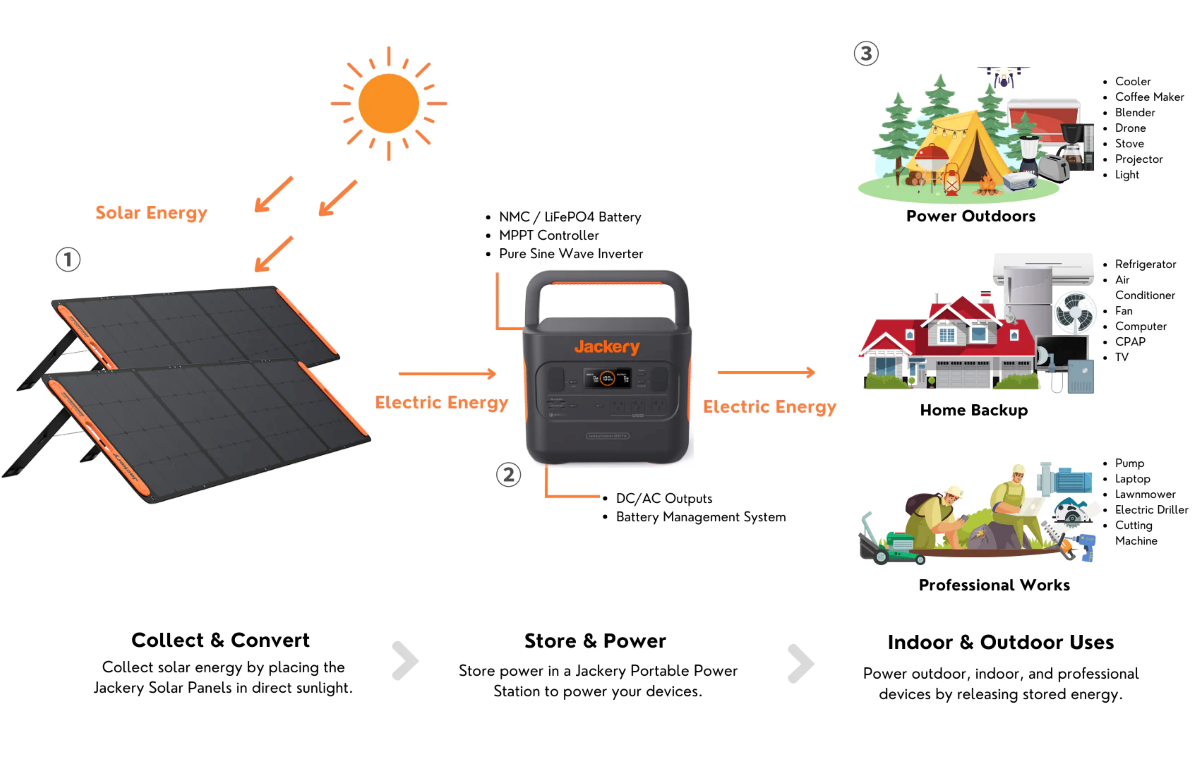 Jackery Solar Generator 3000 Pro
Jackery Solar Generator 3000 Pro
If you want a solar generator that can power appliances during power outages, off-grid living, or outdoor adventures, the large-capacity Jackery Solar Generator 3000 Pro makes sense. The pull rods and double wheels design help you easily transport the solar generator from one location to another. It has an NMC battery of 3024Wh capacity and can keep 99% of your appliances powered up.
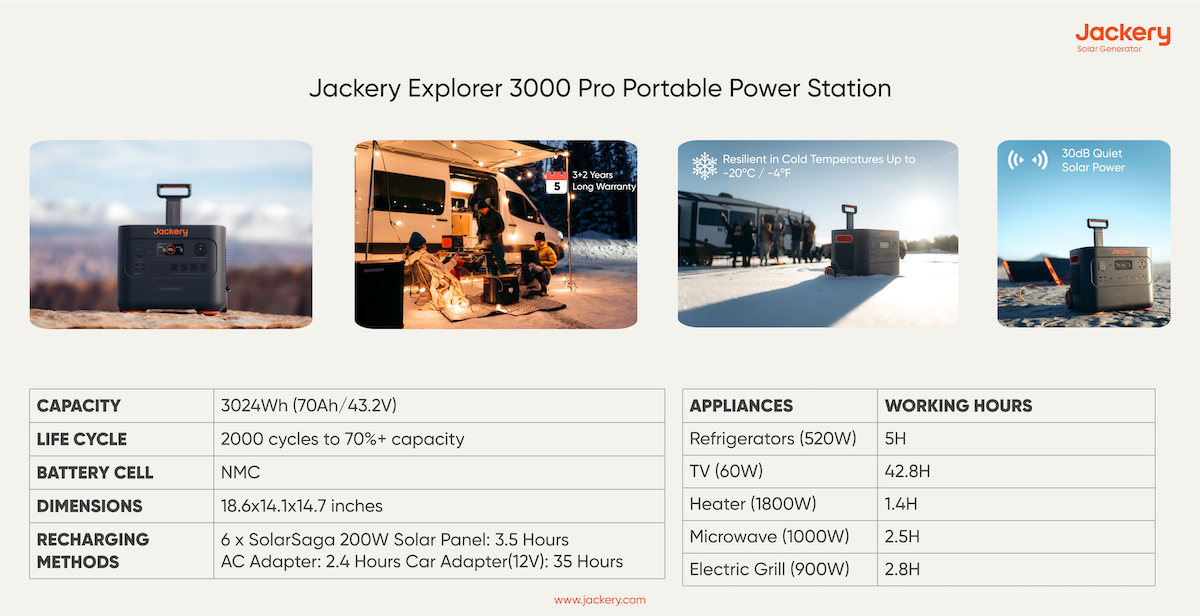 Customer Review
Customer Review
“I was looking to add electricity to my tough shed, and instead of having the whole shed wired from the house, I ran a couple of outlets for lights and power by using my new Jackery Solar Generator 3000 Pro. It allows me to have the power I need and a backup if electricity drops to the house.” — Allen Lewis.
|
|
|
|
Capacity |
3024Wh |
|
Battery Cell |
NMC |
|
Cycle Life |
2000 cycles to 70%+ capacity |
|
Dimension |
Length: 18.6 in (47.24 cm) Width: 14.1 in (35.81 cm) Height: 14.7 in (37.36 cm) |
|
Recharging Methods |
Solar Recharging: 3.5 H (6*Jackery SolarSaga 200W Solar Panels) Wall Recharging: 2.4 H Car Recharging: 35 H |
|
Output Ports |
AC Output (x1): 120V~ 60Hz 25A Max AC Output (x3): 120V~ 60Hz 20A Maximum USB-C Output (x2): 100W Maximum, 5V⎓3A, 9V⎓3A, 12V⎓3A, 15V⎓3A, 20V⎓5A |
|
Working Hours |
Electric Cooker (900W): 2.8H Air Conditioner (1000W): 2.5H Television (60W): 42.8H Microwave Oven (1160W): 2.2H Coffee Maker (800W): 3.2H |
Jackery Solar Generator 2000 Plus
The Jackery Solar Generator 2000 Plus has an expandable battery capacity of 2042.8Wh. It can power heavy-duty devices up to 6000W. If you want to choose a whole-house battery backup solution, consider expanding the LiFePO4 battery from 2kWh to 24kWh with the help of Jackery Battery Pack 2000 Plus.
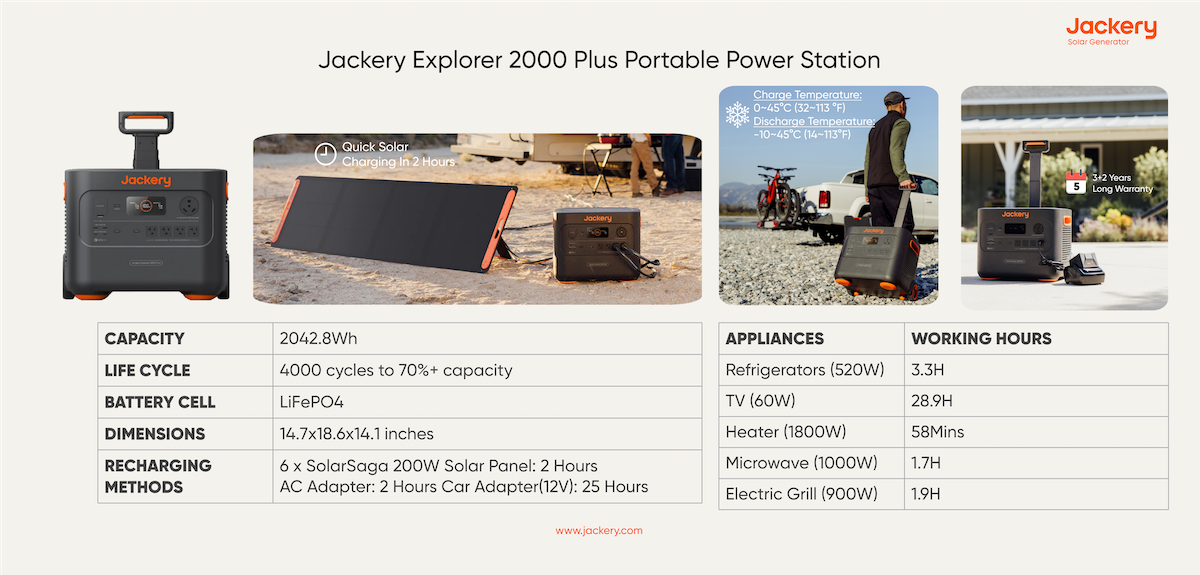 Customer Review
Customer Review
“I like this thing; it's got a lot of power. It powered my air conditioner on high. It powered power tools. It's really not that heavy. It doesn't take too long to charge. And I'll be buying everything to expand the whole system eventually. I like it. It's nice and portable.” — Michael Wheeler.
|
|
|
|
Capacity |
2-24kWh |
|
Battery Cell |
LiFePO4 |
|
Cycle Life |
4000 cycles to 70%+ capacity |
|
Dimension |
Length: 14.7 in (37.36 cm) Width: 18.6 in (47.3 cm) Height: 14.1 in (35.94 cm) |
|
Recharging Methods |
Solar Recharging: 2 H (6*Jackery SolarSaga 200W Solar Panels) Wall Recharging: 2 H Car Recharging: 25 H |
|
Output Ports |
AC Output (×4) 120V~ 60Hz, 20A Maximum AC Output (×1) 120V~ 60Hz, 25A Maximum USB-A Output (x2): Quick Charge 3.0, 18W Maximum USB-C Output (x2): 100W Maximum, (5V, 9V, 12V, 15V, 20V up to 5A) |
|
Working Hours |
Electric Cooker (900W): 1.9H Air Conditioner (1000W): 1.7H Television (60W): 28.9H Microwave Oven (1160W): 1.4H Coffee Maker (800W): 2.1H |
Jackery Solar Generator 1500 Pro
The Jackery Solar Generator 1500 Pro combines Jackery Explorer 1500 Pro Portable Power Station and 6*Jackery SolarSaga 200W Solar Panels. With an NMC battery of 1512Wh capacity, it can charge 95% of appliances efficiently. It's highly durable, long-lasting, and strong, making it an excellent solution for outdoor charging.
 Customer Review
Customer Review
“I actually used it for the first time this past weekend while camping. I was pleasantly surprised by how long the battery lasts. I had several electronics plugged in all weekend, and by the time I packed up to head home, I still had plenty of juice left.” — RYAN W.
|
|
|
|
Capacity |
1512Wh |
|
Battery Cell |
NMC |
|
Cycle Life |
1000 cycles to 80%+ capacity |
|
Dimension |
Length: 15.12 in (38.4 cm) Width: 10.59 in (26.9 cm) Height: 12.11 in (30.75 cm) |
|
Recharging Methods |
Solar Recharging: 2 H (6*Jackery SolarSaga 200W Solar Panels) Wall Recharging: 2 H Car Recharging: 16.5 H |
|
Output Ports |
AC Output (x3): 120V~60Hz, 1800W (3600W Peak) USB-A Output (x2): Quick Charge 3.0×2, 18W Max USB-C Output (x2): 100W Maximum, (5V, 9V, 12V, 15V, 20V up to 5A) |
|
Working Hours |
Electric Cooker (900W): 1.4H Air Conditioner (1000W): 1.2H Television (60W): 21.4H Microwave Oven (1160W): 1.1H Coffee Maker (800W): 1.6H |
Jackery Solar Generator 1000 Plus
The Jackery Solar Generator 1000 Plus is another expandable charging solution with a LiFePO4 battery of 1264Wh capacity. Connecting the additional Jackery Battery Pack 1000 Plus allows you to expand the power station capacity from 1.25kWh to 5kWh. With only 6*Jackery SolarSaga 200W Solar Panels, you can charge the Jackery Explorer 1000 Plus Portable Power Station in only 2 hours.
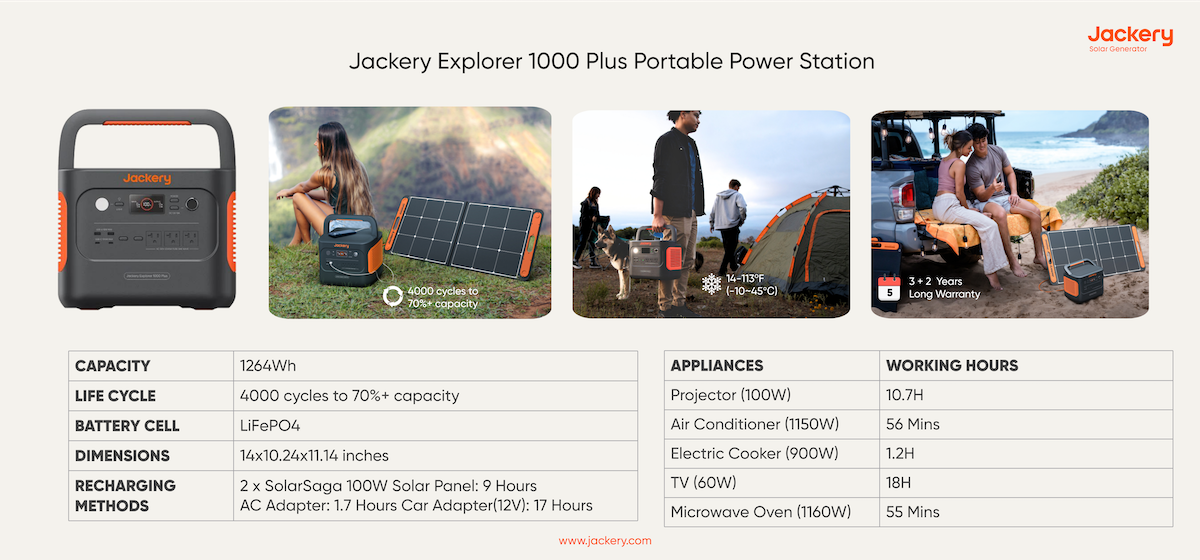 Customer Review
Customer Review
“The Solar Generator 1000 Plus with 2*Jackery SolarSaga 100W Solar Panels is a perfect fit and keeps us powered outdoors away from any power grid. Sufficient to power a 50-quart fridge 24/7 and a coffee maker (1150 W) in the morning, and of course, all our gear, which needs a USB charge from time to time.” — M.
|
|
|
|
Capacity |
1.25 - 5 kWh |
|
Battery Cell |
LiFePO4 |
|
Cycle Life |
4000 cycles to 70%+ capacity |
|
Dimension |
Length: 14 in (35.6 cm) Width: 10.24 in (26 cm) Height: 11.14 in (28.3 cm) |
|
Recharging Methods |
Solar Recharging: 2 H (4*Jackery SolarSaga 200W Solar Panels) Wall Recharging: 1.7 H Car Recharging: 7 H |
|
Output Ports |
AC Output (x3): 120V~60Hz, 2000W (4000W Peak) USB-A Output (x2): 18W Max, 5-5V⎓3A USB-C Output (x2): 100W Maximum, (5V, 9V, 12V, 15V, 20V up to 5A) |
|
Working Hours |
Electric Cooker (900W): 1.2H Air Conditioner (1000W): 1H Television (60W): 17.9H Microwave Oven (1160W): 55 min Coffee Maker (800W): 1.3H |
What Is kVA FAQs
What is the meaning of kVA?
kVA measures the apparent power that is required by the electrical circuit. If the system has 100% efficiency, the values of kVA and kW are equal. However, there is no 100% efficient system, so all the apparent power cannot be converted to useful output.
How many kVA is 1 kW?
One kilovolt-ampere (kVA) equals one kilowatt (kW) in an AC circuit. However, the kVA to kW conversion is affected by the power factor that ranges from 0 to 1. If the PF value is 0.8, there are around 1.25 kVA in 1 kW.
How do I calculate kVA?
If you have volts and amps available for the electrical system, you only need to multiply volts, amps, and 1000.
kVA = Volts × Amps × 1000
On the other hand, if you have the kW value of the electrical system, the kVA can be calculated using the following formula.
kVA = kW ÷ PF, where kW is the real power, and PF is the power factor.
How do I convert kVA to kW?
The formula for converting kVA to kW is as follows:
kW = kVA × PF, where PF is the power factor.
For example, if the given kVA is 100 and the PF value is 0.8, the kilowatts can be calculated as:
kW = 100 × 0.8 = 80 kVA
Final Thoughts
Generators come in different shapes and sizes, and understanding "what is kVA" and "how to calculate kVA" will help you choose the correct size generator for your needs. A generator with a higher kVA value can power your appliances at home, at events, and even during outdoor adventures.
For example, Jackery Solar Generator 3000 Pro has an NMC battery of 3024Wh capacity and provides plenty of power. It is ideal for most scenarios, including long-term power outages, RVing, and camping. It can be recharged using 6*Jackery SolarSaga 200W Solar Panels in only 3.5 hours, making it an excellent choice for off-grid living.
Disclaimer:
The runtime mentioned for appliances powered by Jackery is for reference only. Actual runtime may vary under different conditions. Please refer to real-world performance for accurate results.





































![[Add - on] Jackery Manual Transfer Switch for Explorer 5000 Plus - Jackery](http://www.jackery.com/cdn/shop/files/add-on-jackery-manual-transfer-switch-for-explorer-5000-plus-9017324.png?v=1754016782&width=170)

























































































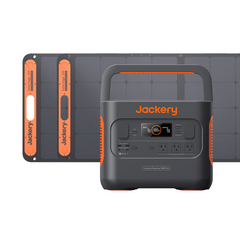

Leave a comment